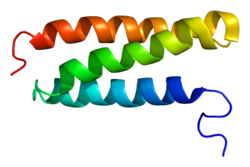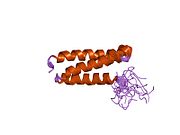VPS4B
| VPS4B | |||||||||||||||||||||||||||||||||||||||||||||||||||
|---|---|---|---|---|---|---|---|---|---|---|---|---|---|---|---|---|---|---|---|---|---|---|---|---|---|---|---|---|---|---|---|---|---|---|---|---|---|---|---|---|---|---|---|---|---|---|---|---|---|---|---|
 | |||||||||||||||||||||||||||||||||||||||||||||||||||
| |||||||||||||||||||||||||||||||||||||||||||||||||||
| Identifiers | |||||||||||||||||||||||||||||||||||||||||||||||||||
| Aliases | VPS4B, SKD1, SKD1B, VPS4-2, MIG1, vacuolar protein sorting 4 homolog B | ||||||||||||||||||||||||||||||||||||||||||||||||||
| External IDs | OMIM: 609983; MGI: 1100499; HomoloGene: 37976; GeneCards: VPS4B; OMA:VPS4B - orthologs | ||||||||||||||||||||||||||||||||||||||||||||||||||
| |||||||||||||||||||||||||||||||||||||||||||||||||||
| |||||||||||||||||||||||||||||||||||||||||||||||||||
| |||||||||||||||||||||||||||||||||||||||||||||||||||
| |||||||||||||||||||||||||||||||||||||||||||||||||||
| |||||||||||||||||||||||||||||||||||||||||||||||||||
| Wikidata | |||||||||||||||||||||||||||||||||||||||||||||||||||
| |||||||||||||||||||||||||||||||||||||||||||||||||||
Vacuolar protein sorting-associated protein 4B is a protein that in humans is encoded by the VPS4B gene.[5][6]
The protein encoded by this gene is a member of the AAA protein family (ATPases associated with diverse cellular activities), and is the homolog of the yeast Vps4 protein.
In humans, two paralogs of the yeast protein have been identified. They share a high degree of amino acid sequence similarity with each other and also with yeast Vps4 and mouse proteins. Functional studies indicate that both human paralogs associate with the endosomal compartments, and are involved in intracellular protein trafficking, similar to Vps4 protein in yeast. The gene encoding this paralog has been mapped to chromosome 18; the gene for the other (VPS4A) resides on chromosome 16.[6]
References
- ^ a b c GRCh38: Ensembl release 89: ENSG00000119541 – Ensembl, May 2017
- ^ a b c GRCm38: Ensembl release 89: ENSMUSG00000009907 – Ensembl, May 2017
- ^ "Human PubMed Reference:". National Center for Biotechnology Information, U.S. National Library of Medicine.
- ^ "Mouse PubMed Reference:". National Center for Biotechnology Information, U.S. National Library of Medicine.
- ^ Scheuring S, Rohricht RA, Schoning-Burkhardt B, Beyer A, Muller S, Abts HF, Kohrer K (Sep 2001). "Mammalian cells express two VPS4 proteins both of which are involved in intracellular protein trafficking". J Mol Biol. 312 (3): 469–80. doi:10.1006/jmbi.2001.4917. PMID 11563910.
- ^ a b "Entrez Gene: VPS4B vacuolar protein sorting 4 homolog B (S. cerevisiae)".
Further reading
- Périer F, Coulter KL, Liang H, et al. (1994). "Identification of a novel mammalian member of the NSF/CDC48p/Pas1p/TBP-1 family through heterologous expression in yeast". FEBS Lett. 351 (2): 286–90. doi:10.1016/0014-5793(94)00879-5. PMID 8082782. S2CID 31778093.
- Mao M, Fu G, Wu JS, et al. (1998). "Identification of genes expressed in human CD34+ hematopoietic stem/progenitor cells by expressed sequence tags and efficient full-length cDNA cloning". Proc. Natl. Acad. Sci. U.S.A. 95 (14): 8175–80. Bibcode:1998PNAS...95.8175M. doi:10.1073/pnas.95.14.8175. PMC 20949. PMID 9653160.
- Scheuring S, Bodor O, Röhricht RA, et al. (1999). "Cloning, characterisation, and functional expression of the Mus musculus SKD1 gene in yeast demonstrates that the mouse SKD1 and the yeast VPS4 genes are orthologues and involved in intracellular protein trafficking". Gene. 234 (1): 149–59. doi:10.1016/S0378-1119(99)00163-8. PMID 10393249.
- Bishop N, Woodman P (2000). "ATPase-defective Mammalian VPS4 Localizes to Aberrant Endosomes and Impairs Cholesterol Trafficking". Mol. Biol. Cell. 11 (1): 227–39. doi:10.1091/mbc.11.1.227. PMC 14770. PMID 10637304.
- Zhang QH, Ye M, Wu XY, et al. (2001). "Cloning and Functional Analysis of cDNAs with Open Reading Frames for 300 Previously Undefined Genes Expressed in CD34+ Hematopoietic Stem/Progenitor Cells". Genome Res. 10 (10): 1546–60. doi:10.1101/gr.140200. PMC 310934. PMID 11042152.
- Howard TL, Stauffer DR, Degnin CR, Hollenberg SM (2002). "CHMP1 functions as a member of a newly defined family of vesicle trafficking proteins". J. Cell Sci. 114 (Pt 13): 2395–404. doi:10.1242/jcs.114.13.2395. PMID 11559748.
- Strausberg RL, Feingold EA, Grouse LH, et al. (2003). "Generation and initial analysis of more than 15,000 full-length human and mouse cDNA sequences". Proc. Natl. Acad. Sci. U.S.A. 99 (26): 16899–903. Bibcode:2002PNAS...9916899M. doi:10.1073/pnas.242603899. PMC 139241. PMID 12477932.
- Beyer A, Scheuring S, Müller S, et al. (2003). "Comparative sequence and expression analyses of four mammalian VPS4 genes". Gene. 305 (1): 47–59. doi:10.1016/S0378-1119(02)01205-2. PMID 12594041.
- Strack B, Calistri A, Craig S, et al. (2003). "AIP1/ALIX is a binding partner for HIV-1 p6 and EIAV p9 functioning in virus budding". Cell. 114 (6): 689–99. doi:10.1016/S0092-8674(03)00653-6. PMID 14505569. S2CID 10733770.
- von Schwedler UK, Stuchell M, Müller B, et al. (2003). "The protein network of HIV budding". Cell. 114 (6): 701–13. doi:10.1016/S0092-8674(03)00714-1. PMID 14505570. S2CID 16894972.
- Fujita H, Umezuki Y, Imamura K, et al. (2005). "Mammalian class E Vps proteins, SBP1 and mVps2/CHMP2A, interact with and regulate the function of an AAA-ATPase SKD1/Vps4B". J. Cell Sci. 117 (Pt 14): 2997–3009. doi:10.1242/jcs.01170. PMID 15173323. S2CID 726248.
- Gerhard DS, Wagner L, Feingold EA, et al. (2004). "The Status, Quality, and Expansion of the NIH Full-Length cDNA Project: The Mammalian Gene Collection (MGC)". Genome Res. 14 (10B): 2121–7. doi:10.1101/gr.2596504. PMC 528928. PMID 15489334.
- Katoh K, Suzuki H, Terasawa Y, et al. (2006). "The penta-EF-hand protein ALG-2 interacts directly with the ESCRT-I component TSG101, and Ca2+-dependently co-localizes to aberrant endosomes with dominant-negative AAA ATPase SKD1/Vps4B". Biochem. J. 391 (Pt 3): 677–85. doi:10.1042/BJ20050398. PMC 1276969. PMID 16004603.
- Takasu H, Jee JG, Ohno A, et al. (2005). "Structural characterization of the MIT domain from human Vps4b". Biochem. Biophys. Res. Commun. 334 (2): 460–5. doi:10.1016/j.bbrc.2005.06.110. PMID 16018968.
- Scott A, Chung HY, Gonciarz-Swiatek M, et al. (2005). "Structural and mechanistic studies of VPS4 proteins". EMBO J. 24 (20): 3658–69. doi:10.1038/sj.emboj.7600818. PMC 1276703. PMID 16193069.
- Kimura K, Wakamatsu A, Suzuki Y, et al. (2006). "Diversification of transcriptional modulation: Large-scale identification and characterization of putative alternative promoters of human genes". Genome Res. 16 (1): 55–65. doi:10.1101/gr.4039406. PMC 1356129. PMID 16344560.
- Welsch S, Habermann A, Jäger S, et al. (2007). "Ultrastructural analysis of ESCRT proteins suggests a role for endosome-associated tubular-vesicular membranes in ESCRT function". Traffic. 7 (11): 1551–66. doi:10.1111/j.1600-0854.2006.00489.x. PMID 17014699. S2CID 36879122.
- Olsen JV, Blagoev B, Gnad F, et al. (2006). "Global, in vivo, and site-specific phosphorylation dynamics in signaling networks". Cell. 127 (3): 635–48. doi:10.1016/j.cell.2006.09.026. PMID 17081983. S2CID 7827573.
- Lambert C, Döring T, Prange R (2007). "Hepatitis B Virus Maturation Is Sensitive to Functional Inhibition of ESCRT-III, Vps4, and γ2-Adaptin". J. Virol. 81 (17): 9050–60. doi:10.1128/JVI.00479-07. PMC 1951427. PMID 17553870.
- v
- t
- e
-
 1wr0: Structural characterization of the MIT domain from human Vps4b
1wr0: Structural characterization of the MIT domain from human Vps4b -
 1xwi: Crystal Structure of VPS4B
1xwi: Crystal Structure of VPS4B -
 2cpt: Solution structure of MIT domain from human SKD1
2cpt: Solution structure of MIT domain from human SKD1
 | This article on a gene on human chromosome 18 is a stub. You can help Wikipedia by expanding it. |
- v
- t
- e






















